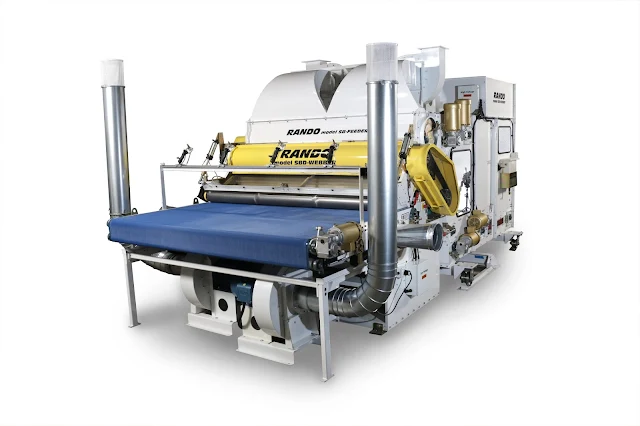What is the Rando Webber?
The Rando Webber is a precision-engineered system for forming airlaid nonwoven mats, designed to deliver uniform weight, consistent loft, and edge quality by ensuring a truly random orientation of fibers. It's been a cornerstone of Rando Machine’s airlaid technology since the late 1940s.
How does it work?
-
Opening & blending: Raw fibers (natural or synthetic) are opened, blended and individualized.
-
Feeding: The fiber mix is transported into the web-forming section.
-
Web formation: In the forming chamber, fibers are conveyed by high-velocity airstreams and centrifugal force onto a condenser cylinder or belt, resulting in a uniform nonwoven web.
Why choose a Rando Webber?
🎯 Key Advantages
-
Uniform weight, loft, and clean edges through true random fiber orientation.
-
Available in three condenser types:
-
SB: For coarse fibers (100+ denier)
-
SD: For fine fibers (nano to 100 denier)
-
SHL: Enables high-loft webs up to 10″ with simple HMI speed adjustments
-
-
Handles a wide range of fiber types: glass, synthetics, hemp, cotton, wood, and more.
-
Web basis weights can range from roughly 10 to 3,000 g/m² depending on the application.
Rando Machine: Legacy & Innovation
Founded in the 1940s, Rando Machine Corporation has led the way in nonwoven web-forming innovation since launching the first commercial 40″ Rando Webber in 1949. Based in Victor, New York, the company has expanded internationally and added a second manufacturing facility.
Their product portfolio includes:
-
Complete fiber preparation systems: bale breakers, feeders, opener/blenders, volumetric reserves.
-
Pilot line services for blend testing and prototyping.
-
Replacement parts and service support—even for legacy machinery.
A recent innovation includes the Rando™ Shredder Waste Reducer, which recovers edge trims and reincorporates regenerated fiber into production—boosting sustainability and reducing waste.
Common Applications
Rando Webber systems support a broad range of industries, including:
-
Insulation: thermal and acoustic, up to 10″ thick
-
Medical and hygiene: for applications requiring strength and consistency
-
Specialty textiles: aerospace, defense, agriculture, and research—using carbon fiber, nano‑fibers, seaweed, metallic fibers, and more
Typical web weights range from 25 to 2,500 g/m², depending on use case and fiber blend.
FAQs
| Question | Answer |
|---|---|
| What fiber types can it handle? | Natural and synthetic fibers—cotton, jute, hemp, fiberglass, nano‑fibers, and more |
| What are the production speeds? | SD: up to ~150 ft/min; SB: up to ~66 ft/min; SHL adjusts via HMI for loft control |
| What are typical widths? | From ~12″ up to around 110″, depending on model |
| Are parts and service available globally? | Yes—Rando provides parts, retrofits, and technical support worldwide |
| Can the Webber be tried before purchase? | Yes—customers can run trials and test fiber blends in Rando’s on-site pilot lab |
-
Rando Webber is a high-performance airlaid nonwoven formation system known for unmatched fiber uniformity and process flexibility.
-
Rando Machine offers a comprehensive solution from fiber prep to web forming, including pilot testing and full-service support.
-
Rando systems serve a wide range of industries with customizable solutions for various fiber types, weights, and web structures.




Comments
Post a Comment